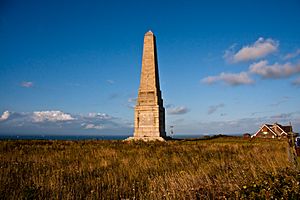Culver Down facts for kids
Quick facts for kids Culver Down |
|
|---|---|

Culver Down seen from Sandown Bay, 2003
|
|
| Highest point | |
| Elevation | 104 m (341 ft) |
| Geography | |
| Location | Isle of Wight, England |
| OS grid | SZ631856 |
| Topo map | OS Landranger 196 |
Culver Down is a beautiful chalk hill on the Isle of Wight, near Sandown. It's a well-known spot with amazing views. Its name might come from an Old English word, "Culfre," which means dove.
Contents
Exploring Culver Down
This area is home to many interesting plants and animals. On the southern and eastern slopes, you can find plants like Small Scabious, Harebell, Cowslip, and Lady's Bedstraw. The tall chalk cliffs on the north and east sides are perfect places for seabirds to build their nests.
Long ago, people used to collect bird eggs from these cliffs using ropes. Culver Down was also known for its peregrine falcons and Common Woodpigeons. In fact, the "Culvers" (woodpigeons) are thought to be the reason for the cliff's name.
The northern part of the down is used for grazing cattle. Because of this, and because it was once an artillery training ground, much of the natural chalk ecosystem has changed.
Unusual Ants of Culver Down
Culver Down is a special place for ants. Some unusual ant species live here. One example is the Solenopsis fugax, also known as a thief ant. Another ant, Ponera coarctata, has also been found in this location. These tiny creatures add to the unique wildlife of the down.
Public Access and Views
The public parts of Culver Down are looked after by the National Trust. This organization helps protect important natural and historical places. From Culver Down, you can enjoy fantastic views of the English Channel.
A Look at Culver Down's History
For many years, Culver Down was a military area and not open to the public. Today, you can still see several old military features on the down. There are also some private homes, the Culver Haven pub, and a very noticeable monument.
The military barracks that were once next to the monument are mostly gone now. However, there is a large fort that the National Trust owns. Sometimes, this fort is opened for visitors to explore. Part of the fort is leased to a company that makes equipment for crop-spraying and military use. This fort is a Palmerston Fort, built in the 1860s. At the very end of the cliff, there's also a coastal and anti-aircraft battery from the Second World War.
Historical Events and Legends
In 1545, a French army landed nearby and tried to attack Sandown. Local fighters, led by Sir John Oglander, stopped them on Culver Down. The French were eventually pushed back at Sandown.
The famous poet Algernon Charles Swinburne once wrote that when he was 17, he climbed these cliffs. He did this to show his family how brave he was after they wouldn't let him join the army.
There's also an old legend about a hermit who lived in a cave at the end of the cliffs in the 14th century. This area was then called Culver Ness. The hermit supposedly predicted that a well in a nearby village would be poisoned. When a pilgrim came to bless the well, the villagers are said to have killed him. Soon after, the French attacked the village, and it was lost under the trees. A great storm then destroyed the Ness and drowned the hermit. People believed this was a punishment from above.
The Yarborough Monument
The monument you see on Culver Down is a memorial to Charles Anderson-Pelham, 1st Earl of Yarborough. He was the 2nd Baron Yarborough and later became the first Earl of Yarborough. He was also the founder of the Royal Yacht Squadron in Cowes.
This monument was first put up in 1849 on a different hill called Bembridge Down. It was moved to its current spot in the 1860s. This happened because the original site was needed to build one of the Palmerston forts.


